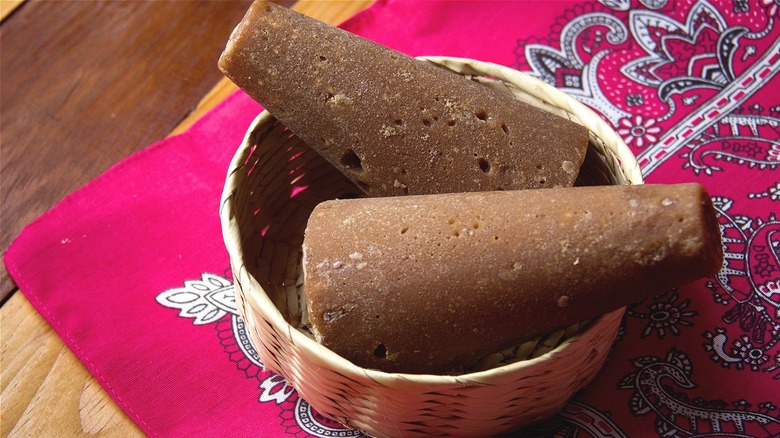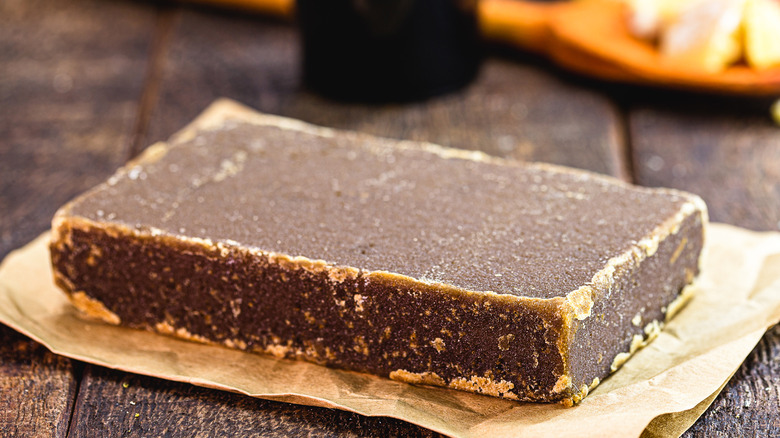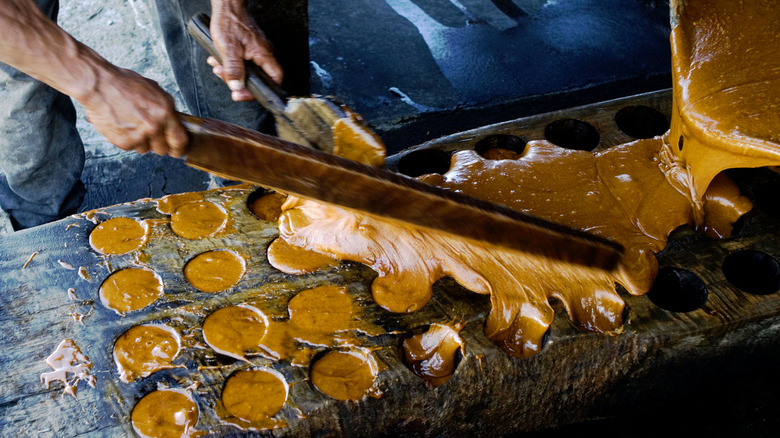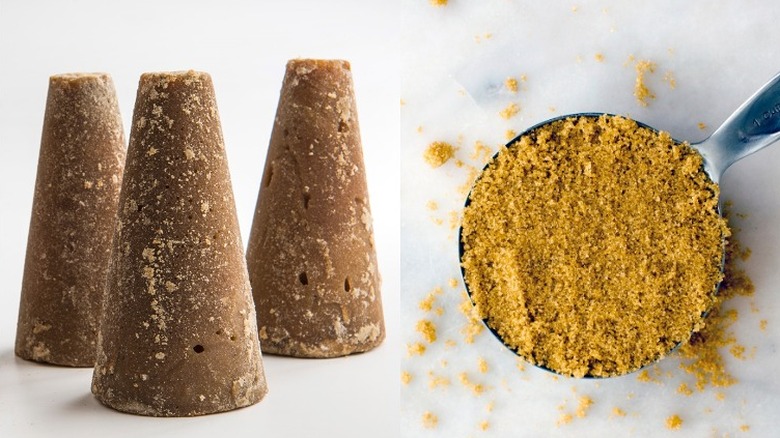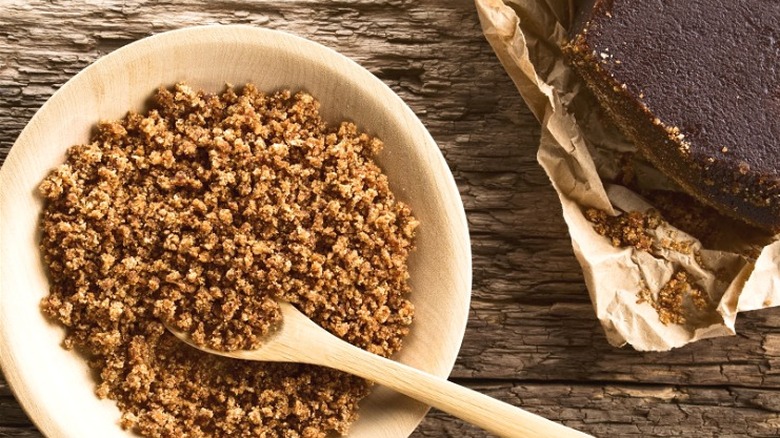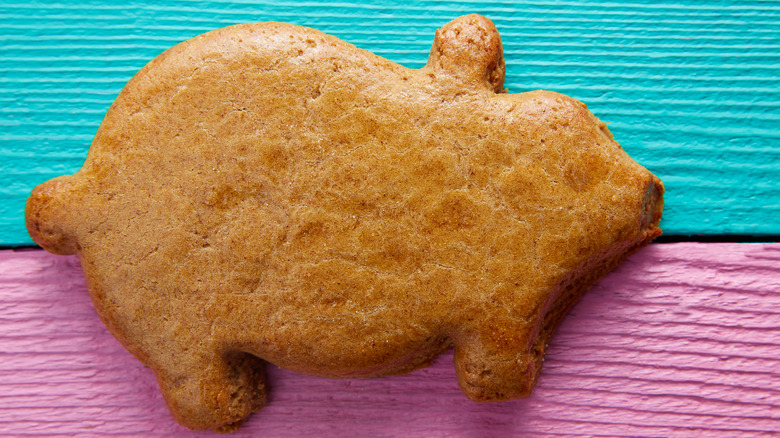What Is Piloncillo And How Do You Use It?
If you're always looking for new ways to indulge your sweet tooth, you should definitely learn more about piloncillo, a unique variety of cane sugar. Piloncillo (pronounced pee-lon-SEE-yoh according to Mex Grocer) is widely used in Mexico and other Latin American countries. According to Isabel Eats, it's a type of cane sugar that goes through far fewer processes than regular white or brown sugars, and so has a richer and more complex flavor. Piloncillo is sold as a hard mass of dark brown sugar, with shapes that include plastic-wrapped cones, small loaves, flat bricks, and disks. Piloncillo sizes can range from just a couple of ounces up to a pound.
This distinctive, unrefined sugar has been a part of Latin and South American food culture since the 1700s, after sugar cane plants were first brought to the continent by European invaders (via Imepex.) Piloncillo is an integral ingredient in many traditional dishes, both savory and sweet, of these countries.
Other names for this sweet
Just as with common brown sugar, piloncillo is available in light ("blanco") and dark ("oscuro") varieties, with oscuro having the stronger molasses flavor of the two (via Isabel Eats).
According to Just Panela, you may see this type of sugar labeled under other names as well. Rapadura (or raspadura) is the name it goes by in some Central American countries and Brazil, but in Costa Rica and Nicaragua it's called tapa dulce. Along the Pacific coast of the South America, this sugar is known as chancaca. In Venezuela it's papelón, in Guyana it's demerara, and in Colombia and Ecuador it's panela. And as for piloncillo? That's the name used for this tantalizing sugar in Mexico. Be sure not to make the mistake of asking for panela in Mexico, because you'll likely get a wedge of fresh cow's milk cheese that goes by that name (via Cheese).
How is piloncillo made?
Cane sugar products like piloncillo are made by thousands of small producers in Mexico and throughout Central and South America (via New York Times.) Unlike granulated white and brown sugars, piloncillo is an unrefined sugar, sometimes called raw sugar, meaning that the steps to create it are simple and few. This makes it possible for even small family farms to grow sugarcane and create piloncillo products.
Spruce Eats shares that to make piloncillo, freshly cut stalks of sugarcane are pressed to squeeze out all the sugarcane juice. This liquid is then boiled in large kettles over fires that are made with the chopped sugarcane fibers left over from the pressings. As the liquid sugar boils it becomes dark and thick, concentrating the sweetness and flavors. When ready, the boiled sugar has a golden, creamy look like that of liquid caramel, and it's quickly poured into molds shaped like cones, bricks, or round disks. The sugar is left to cool and harden, after which the blocks can be popped out of the molds and packaged for retail sale.
Piloncillo versus regular brown sugar
Because piloncillo is widely used in Mexican dishes, it's sometimes labeled or referred to as "Mexican brown sugar" (via Spruce Eats). However, there are many differences between piloncillo and the bags of soft brown sugar we're used to grabbing off the baking aisle shelf. The biggest difference is that piloncillo is an unrefined sugar: a minimal number of steps are needed to turn stalks of sugarcane into chunks of piloncillo. There are light and dark varieties, determined by the age of the sugarcane stalks (with younger, green stalks yielding a lighter piloncillo.)
In contrast, brown sugar is made using white, refined sugar. White sugar is made from either sugarcane or sugar beets, and goes through several processing steps to extract the juice, crystallize it, remove molasses, and remove impurities to make it white — including using bone char. A small amount of molasses is then added back to the white sugar to create light brown sugar, or slightly more to create dark brown sugar. Brown sugar tastes sweet with a light molasses flavor (which is slightly stronger, of course, in dark brown sugar). The flavor of piloncillo, however, is different.
What does piloncillo taste like?
You expect to get a big hit of sweetness when adding sugar in any form to your dish or drink, but with piloncillo there is a unique flavor as well; a flavor that's more complex and intriguing than that of regular white or brown sugars.
Because piloncillo is made from sugarcane juice boiled over an open fire, it's not surprising that Spruce Eats notes it has hints of "burnt caramel, with some smokiness." Serious Eats also shares that piloncillo can have flavors of dark rum, and a hint of acidity that works nicely with the sweetness. They also say that piloncillo tastes a bit less sweet than refined sugar. Just Panela adds that piloncillo can have additional flavor notes of molasses and even raisins, another sweet treat created by concentrating the sugars found naturally in the plant.
Because piloncillo is unrefined, it retains naturally occurring vitamins and nutrients, like potassium and calcium (via Just Panela). Because of this, piloncillo and other sugars that are less refined are often touted as being a healthier option over white sugar. However, piloncillo is still sugar, and benefits of its trace nutrients are outweighed by the potential health problems, like diabetes and heart disease, caused by excess sugar consumption (via Healthline).
How to use piloncillo
According to Isabel Eats, piloncillo is used in many traditional Mexican dishes and sweets. One favorite drink is café de olla, a hot, spiced coffee with piloncillo added to the pot to melt, adding sweetness and molasses flavor. Serious Eats shares that another beloved piloncillo beverage is champurrado, a rich hot chocolate thickened with corn masa flour. Agua panela is made by dissolving piloncillo in water with lime juice added, to create a refreshing and replenishing drink. There are plenty of savory applications too, such as added to saucy dishes like Serious Eats' Chicken with Tomatillo and Red Chile sauce.
While savory dishes and drinks are tantalizing, we can't talk about a flavorful sugar like piloncillo without diving into desserts! Isabel Eats recommends using piloncillo to replace some or all of the regular sugar called for in dessert and baking recipes, such as flan or capirotada, a fruit and nut-filled bread pudding. Mexico In My Kitchen shares a recipe for traditional Marranitos (also called puerquitos): piggie-shaped cookies sweetened and spiced with piloncillo as well as cinnamon and allspice. It's worth trying piloncillo with drinks, fruit, and other dishes where you'll really be able to taste it.
Piloncillo is usually quite hard: cut pieces off with a serrated knife or grate it with a sturdy grater or microplane (per Isabel Eats). You can also briefly microwave piloncillo to soften it up.
Here's where to find piloncillo
If you're lucky enough to have a market close by that stocks Mexican and Latin American foods, Spruce Eats says you should have no trouble finding piloncillo to take home and try. Look for the brown, plastic-wrapped cones from many brands including Goya. Well-stocked, larger grocery stores may also carry piloncillo in their Latin or international food aisles. There are several online sources, such as MexGrocer.com and Amazon, where you can find piloncillo cones, slabs, and sometimes even granulated versions.
Isabel Eats notes that piloncillo is considered not just a sweetener, but also a spice in so many savory and sweet Mexican foods, thanks to that complex flavor. It's worth checking local spice shops, natural foods stores, and shops specializing in international foods for piloncillo cones or slabs. Finally, as Just Panela points out, remember that piloncillo goes by many other names like rapadura, panela, and tapa dulce, and you may see these when shopping online or at the store. If it's a cone, brick, or chunk of hardened, dark brown sugar from Mexico, Central America, or South America, then you've likely found your piloncillo.
